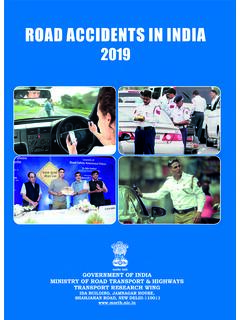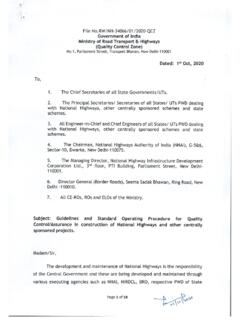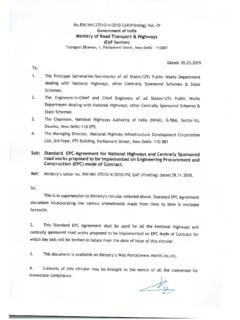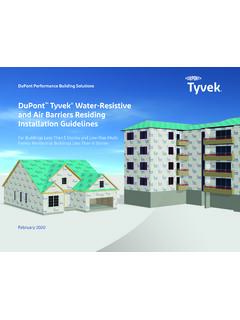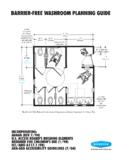Transcription of Technical Circular Guidelines for Metal Crash Barrier ...
1 ; RW/NH-29023/02/2019-S&R(P&B) Government of India Ministry of Road Transport &Highways Zone-S&R (P&B) Transport Bhawan, 1, Parliament Street, New Delhi -110001. To, Dated: 01st January,2020 1. The Chief Secretaries of all the State Governments/ UTs. 2. The Chairman, National Highways Authority of India, G-5 & 6, Sector-10, Dwarka, New Delhi-110 075. 3. The Managing Director, NHIDCL, PTI Building, New Delhi-110001. 4. The Principal Secretaries/ Secretaries of all States/ UTs Public Works Department/ Road Construction Department/ Highways Department (dealing with National Highways and other centrally sponsored schemes). 5. All Engineers-in-Chief and Chief Engineers of Public Works Department of States/ UTs/ Road Construction Department/ Highways Departments (dealing with National Highways and other centrally sponsored schemes).
2 6. The Director General (Border Roads), SeemaSadakBhawan, Ring Road, New Delhi- 110 010. 7. All CE-ROs, ROs and ELOs of the Ministry. Subject: - (A) Guidelines for providing type of Median on National Highways Network; and (B) Guidelines for Metal Crash Barrier (Semi Rigid) to be installed on National Highways. A. Type of Median It has been observed that raised medians are being provided along most of the National Highways/Expressways. As per Manual of Specifications & Standards for Expressways (IRC:SP:99-2013), only depressed or flush median is to be provided on Expressways. Such types of medians are essential on high speed corridors for safety of the road users.
3 The IRC Guidelines for 4 /6 laning of highways permit use of raised median for open country areas also. Since the multi-lane highways being designed as partially controlled highway for higher speeds, raised median may be a safety hazards and may cause severe accidents/fatalities once the errant vehicle strike the raised median. 2. As such, while proposing the median for the divided multilane highways / expressways following may be followed invariably: (i) Only depressed or flush median shall be provided on all the Expressways. No Raised median / kerbs shall be provided on Expressways. (ii) In future, all multi-lane highways shall be provided with depressed/flush median depending upon availability of land.
4 No raised/kerb median shall be provided especially in the open country/rural stretches of National Highways. In case of flush Page 1 of 5 type medians; provision of Crash Barrier and antiglare measures shall also be provided for safety consideration and headlight glare respectively. (iii) In case of narrow medians(2m or less wide), as generally provided in urban areas, New Jersey type concrete Crash barriers shall be used along with anti-glare screen. (iv) In already developed multi-lane expressway /highways with raised median especially in open country / rural areas these shall be replaced by depressed/flush median. Alternatively, Crash Barrier may be provided along raised median in such a way that the face of the Crash barriers is flushed with the face of the raised median.
5 B. Metal Crash Barrier (Semi-Rigid) 3. To avoid major/fatal accident on Highway network, Crash barriers of appropriate type are installed at accident prone locations especially at locations like valley sides of hilly roads, high embankments, sharp/blind curves etc. These are very useful in containing, redirecting and absorbing impact energy of the hitting vehicles and reducing the severity of the accidents. The selection of Barrier is driven by no. of factors such as performance capability, deflection of the Barrier on impact, site condition, compatibility, installation and maintenance cost etc. To reduce the severity of the accident, the vehicle should remain upright after the impact.
6 When the vehicle hits the Crash Barrier , it is generally preferred that the Crash Barrier should not deflect for a distance more than the space available for the deflection. The Crash barriers should have adequate height & length so that the Crash Barrier is able to withstand the impact of the vehicle without the entire Crash Barrier getting thrown off. 4. The location of various types of road side/median Crash barriers and type of Crash Barrier ( concrete/new jersey, semi-rigid/ Metal , flexible/wire rope Barrier ) shall be decided as per the relevant IRC Guidelines and Technical feasibility. 5. The detailed guideline and specification for erecting various traffic safety barriers have been stipulated in IRC 119-2015 ' Guidelines for traffic safety barriers '.
7 This guideline also covers the W-Beam and Thrie Beam type of semi rigid steel Barrier . However, the detailed performance criteria have not been specified in this guideline. It has been decided that before erecting semi rigid Crash Barrier on National Highway, it should be Crash tested 'Road restraint system' and should meet the requirements of EN 1317 Part-2: Performance classes, impact test acceptance criteria and test methods for safety barriers and vehicle parapets and/or to the requirement of the American Manual for Assessing Safety Hardware (MASH). The manufacturer or the contractor shall demonstrate the compliance of these requirements by submission of videos of actual Crash testing along with authenticated Crash test reports.
8 The Crash tests must have been conducted in accredited Crash test laboratories/ institutions. 6. The selection, design, installation and maintenance of the Crash Barrier must consider the operation of the Barrier as the entire system. This should also include all addition components such as transition, end terminals etc. All road safety Barrier installed on the road network must be installed and maintained by qualified personnel. The primary criteria for the approval of the Crash Barrier is that it must have been successfully Crash tested and result evaluated in accordance with EN 1317 part-Z and/ or MASH. 7. There are various factors that play a major part in determining the type of Barrier to be proposed for a particular situation/ stretch.
9 The density of the traffic and traffic compositions are to be considered for specifying the containment level of the Crash Barrier to be provided. The suggestive Guidelines in this regard are as under:- Page 2 of 5 Containment level and working width depending upon the site condition may be specified in the tender document/ scope of the work as per the following suggested value: - Type of Crash Terrain Working Containment Remarks Barrier Width(*) level Containment Level H2:- Car of 900 kg, Speed 100 Kmph, Impact angle W3 (WN<= ) 20 degreesand, Hilly Or W4 (WN<= ) Bus of 13,000Kg, speed 70 Kmph, impact angle 20 degrees Thrie Beam H2 as per EN (single sided/ 1317 - part 2 Containment Level TL4.)
10 - double sided OR Car of 1100 kg, Speed 100 Kmph, Impact angle on median) TL4 as per 25 degreesand, MASH Plain/ W4 (WN<= ) rolling Or Pick up of 2270 kg, speed 100kmph, impact W5 (WN<= 1. 7m) angle 25 degreesand, Single unit truck 10,000kg, speed 90 kmph, impact angle 15 degrees Containment Level H1 :- Car of 900 kg, Speed 100 Kmph, Impact angle Hilly W3 (WN<= ) 20 degreesand, Or W4 (WN<= ) H1 as per EN Bus of 10,000Kg, speed 70 Kmph, impact W- Beam 1317-part2 angle 1 5 degrees (single sided/ OR Containment Level TL4:- double sided Car of 1100 kg, Speed 100 Kmph, Impact angle on median) W3 (WN<= TL4 as per 25 degreesand, Plain/ Or MASH rolling W4 (WN<= ) Pick up of 2270 kg, speed 1 OOkmph, impact Or angle 25 degreesand, W5 (WN<= 1.)



